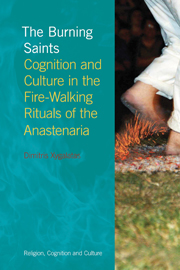Book contents
- Frontmatter
- Dedication
- Contents
- List of illustrations
- Acknowledgements
- 1 Introduction
- 2 Tradition in the making
- 3 The ethnographic setting
- 4 Fire-walking in Agia Eleni
- 5 Knowledge and revelation among the Anastenaria
- 6 Ritual and mind
- 7 Costly rituals
- 8 Arousal, emotion and motivation
- 9 The physiology of high-arousal rituals
- 10 Putting it all together
- Notes
- Bibliography
- Index
2 - Tradition in the making
- Frontmatter
- Dedication
- Contents
- List of illustrations
- Acknowledgements
- 1 Introduction
- 2 Tradition in the making
- 3 The ethnographic setting
- 4 Fire-walking in Agia Eleni
- 5 Knowledge and revelation among the Anastenaria
- 6 Ritual and mind
- 7 Costly rituals
- 8 Arousal, emotion and motivation
- 9 The physiology of high-arousal rituals
- 10 Putting it all together
- Notes
- Bibliography
- Index
Summary
The Anastenaria are communities of Orthodox Christian devotees known for their exciting rituals, namely the fire-walking ceremonies that they perform in honour of Saints Constantine and Helen. Notwithstanding the explicitly Christian character of these groups, Greek ethnographers and historiographers have traditionally considered the Anastenaria's practices as pagan, originating from the ancient orgiastic cults of Dionysus. Upon closer scrutiny, however, it will become apparent that this view lacks any evidential support and is based on ideological grounds alone. In this chapter, I will delineate the history of the Anastenaria as it is known from the available evidence, and subsequently I will discuss the claims on the Dionysian origins of this tradition, the explicit and implicit motivations behind those claims, and their implications not only for the ethnographic representation of this tradition, but also for the tradition itself.
From Eastern Rumelia to Northern Greece
The tradition of the Anastenaria was brought to Greece by refugees from the area of Strandja, at the Black Sea coast, which used to be part of the Ottoman Empire and today is divided between Turkey and Bulgaria. This area was inhabited by Bulgarians, Greeks and Turks. Fire-walking rituals had long been performed there, in several villages with a Christian (Greek, Bulgarian or mixed) population (Arnaudov 1935; Romaios 1944–45). In most of those villages fire-walking was held in honour of Saint Constantine, while in others the celebration was dedicated to Saint Panteleimon or Saint Ilias.
- Type
- Chapter
- Information
- The Burning SaintsCognition and Culture in the Fire-Walking Rituals of the Anastenaria, pp. 13 - 34Publisher: Acumen PublishingPrint publication year: 2012



